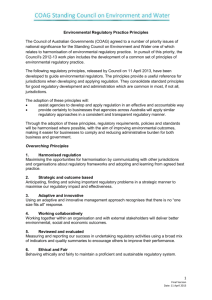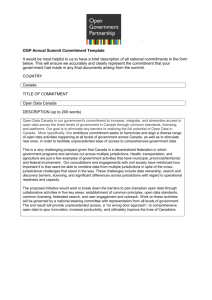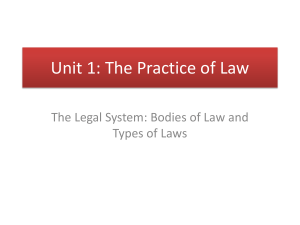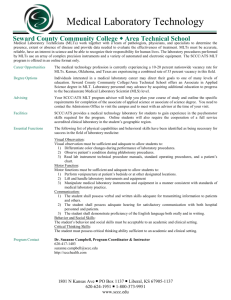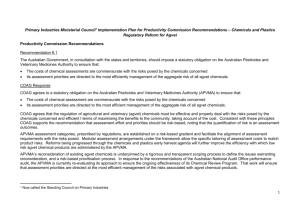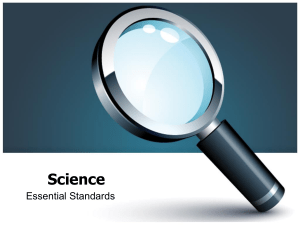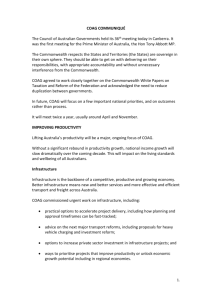Review of Carbon Reduction and Energy Efficiency Measures
advertisement
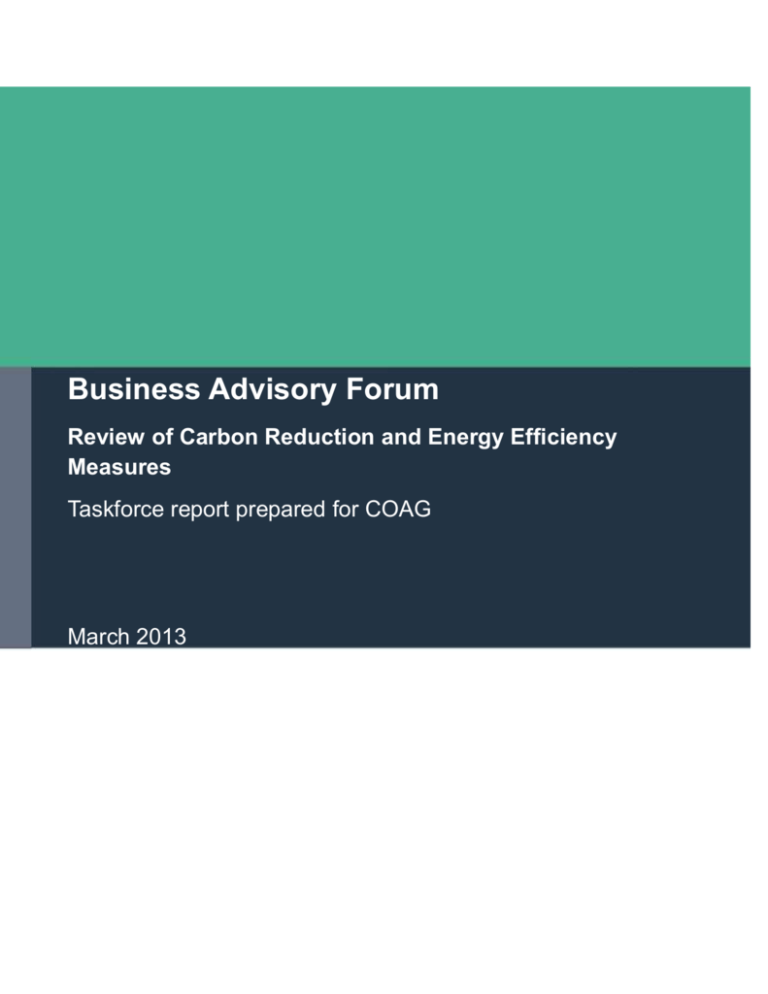
Business Advisory Forum Review of Carbon Reduction and Energy Efficiency Measures Taskforce report prepared for COAG March 2013 Table of Contents 1. INTRODUCTION ................................................................................................ 3 1.1 COAG requests and the Business Advisory Forum ........................................... 3 1.2 Purpose of this report ........................................................................................ 3 2. SCCC REVIEW PROCESS ................................................................................ 4 2.1 Quality of review processes .............................................................................. 4 2.2 Review outcomes .............................................................................................. 4 3. REMAINING MEASURES .................................................................................. 6 3.2 Measures removed outside of the SCCC review process ................................. 8 4. SUMMARY OF FINDINGS ................................................................................. 8 2 1. Introduction 1.1 COAG requests and the Business Advisory Forum Following the inaugural meeting of the Business Advisory Forum (BAF), COAG agreed on 13 April 2012 to prioritise the completion of a review of unnecessary carbon reduction and energy efficiency schemes and requested advice from the Business Advisory Forum (BAF) Taskforce (the Taskforce) on how to fast track and rationalise policies and programs that are not complementary to a carbon price, or are ineffective, inefficient or impose duplicative reporting requirements on business. Following advice from the Taskforce, COAG agreed on 25 July 2012 that existing work scheduled to be undertaken by the Select Council on Climate Change (SCCC) would be adapted to meet COAG’s request. The SCCC, which was established by COAG in February 2011, is required by its Terms of Reference to develop a national approach to assessing the complementarity of existing and future carbon reduction measures with the carbon price mechanism. At its 25 July 2012 meeting, COAG agreed a methodology and timeframe for the SCCC to complete this work, and agreed a list of 74 carbon reduction and energy efficiency measures that would be reviewed. The SCCC has finalised these reviews and will provide a report to COAG in April 2013. In addition to this review activity, COAG agreed on 25 July 2012 that the final stage of this reform would involve the Taskforce carrying out an assessment of overall review outcomes, and requested that this advice and advice on whether any further reform action is required, be provided to COAG by April 2013. This additional assessment would provide COAG and business with an assurance that the reviews conducted by jurisdictions under the SCCC process had been comprehensive and rigorous, and that all relevant measures, particularly those that imposed a regulatory impact on business, had been considered. It also responds in part, to concerns raised by business and other stakeholders regarding the complexity and overlap of carbon reduction and energy efficiency measures and programs, and the: need for a single clear statement from COAG on the intended reform outcome; need for transparency concerning which programs will be subject to review as part of this reform; lack of clarity concerning the scope of programs to be reviewed, particularly where measures were to be subject to independent review or already established review processes, and the extent to which COAG’s objectives would be addressed; need to demonstrate that the cumulative impacts of measures has been assessed, including overlaps between State and Territory and Commonwealth programs; and importance of identifying and removing overlaps in reporting, as it is a significant burden on business. 1.2 Purpose of this report The purpose of this report is to respond to COAG’s request of 13 April 2012. This report assesses, based on advice provided by jurisdictions, the rigour of the SCCC review process (including the extent to which the COAG-agreed principles and review criteria were applied); the review outcomes (including the number of measures that have been retained, removed or revised); and the number and nature of remaining carbon reduction and energy efficiency measures that were not captured by the SCCC process. 3 2. SCCC REVIEW PROCESS 2.1 Quality of review processes COAG agreed on 25 July 2012 that 74 carbon reduction and energy efficiency measures would be reviewed by the SCCC. These measures were self-nominated by jurisdictions, with jurisdictions prioritising for review those programs judged to be of most significant interest/concern to business, with additional consideration given to measures that were primarily designed to produce greenhouse gas abatement or to achieve energy savings, and which have indirect greenhouse gas abatement outcomes. COAG further agreed that the following criteria would apply to these reviews: jurisdictions would undertake reviews of the measures in accordance with their own policies and guidelines for review of measures, and consistent with their resources; jurisdictions would assess measures against the SCCC endorsed revised COAG complementarity principles (Attachment A); in addition to assessment against the complementarity principles, measures identified in this process would be assessed for overall cost-effectiveness and not solely on their cost of abatement; measures would also be assessed specifically to determine if they duplicate existing energy and greenhouse reporting requirements within and across jurisdictions, and if so, report on how these requirements can best be streamlined; and where independent or existing review processes have commenced, or have been recently completed, all jurisdictions would identify options to fast-track timelines to ensure reviews are completed by late 2012 and ensure the agreed methodology is considered. Jurisdictions have reported to the Taskforce on the extent to which the above criteria were applied, including the level and method of review activity and analysis undertaken. With the exception of Western Australia, which at the time of finalisation of this information was subject to caretaker conventions, all jurisdictions have reported that the reviews were undertaken consistent with the SCCC process, that is, nominated carbon reduction and energy efficiency measures have been fully assessed against the COAG agreed complementarity principles, for overall cost-effectiveness. Where a measure has been assessed as meeting this criterion, the SCCC has asked jurisdictions to report whether duplication across jurisdictions exists, and where it can be streamlined. It is not possible for the Taskforce to independently assess, based on the information provided by jurisdictions, the quality of the review process, beyond this. It is noted however, that publication by jurisdictions of reviews or review reports, including details of the methodology, review process and evidence considered, would provide a degree of transparency and a greater assurance to stakeholders that nominated measures have been subject to a rigorous review process. Currently, jurisdictions have reported that only 33 of the 74 reviews are publicly available. 2.2 Review outcomes Jurisdictions have reported to the Taskforce that 61 of the 74 SCCC reviews have been completed (Table 1 refers). This does not include the nine measures nominated by Western Australia for review as part of the SCCC process, as Western Australia’s input to the SCCC was not able to be finalised prior to it entering caretaker arrangements. 4 Jurisdictions have indicated that to date, decisions have been taken by governments to retain, remove or revise measures for 56 of the measures reviewed. Decisions on 18 measures remain pending. Where decisions have been taken by governments, jurisdictions have reported that 7 measures will be, or have been, rationalised (including to remove duplication); 15 measures will be discontinued; and 34 measures will be continued. Review outcomes Review actions completed Not complementary or not cost effective or duplicative Review not completed Rationalis ed Discontinued Continui ng Decisions not yet taken Jurisdicti on Measures reviewed Complementary/ cost effective/not duplicative CTH 4 3 1 0 1 0 2 1 ACT 5 2 1 2 0 1 2 2 NSW 14 12 1 1 3 3 7 1 NT 1 1 0 0 0 0 0 1 QLD 16 13 3 0 0 10 6 0 SA 7 5 2 0 1 0 5 1 TAS 14 13 1 0 0 0 12 2 VIC 4 0 3 1 2 1 0 1 WA* 9 -- -- -- -- -- -- 9 TOTAL* 74 49 12 4 7 15 34 18 Table 1: Summary: outcomes of reviews and action by governments *As WA had an election scheduled for 9 March, government consideration of Western Australia’s Complementarity Measures Review (9 in total) was not completed before the caretaker period commenced. The sub-total for the ‘Measures Reviewed’ column excluding WA is 65 measures in total. The majority of measures, 49 or some 80 per cent of all measures reviewed, were found to be complementary to the carbon price. In addition to complementarity, these measures were assessed against the principles of efficiency, effectiveness, equity and administrative simplicity (as set out in the COAG-agreed principles) and found to be compliant. Governments have agreed, on the basis of these reviews to retain 34 of these measures, with decisions still pending on a number of these reviews. A total of 12 measures were found to not meet COAG’s criteria. Jurisdictions have reported that the reviews of these measures found that they either did not address a market failure, were not positively influencing the impact of the carbon price, or were creating unnecessary burden on business. These 12 measures have been removed, or the relevant government has agreed to either bring forward the scheduled closure date for the measure or agreed to not renew the measure once the existing closure date ends. 5 In addition seven measures have been rationalised (including to remove duplication) as a result of the review process, in order to bring them in line with the criteria agreed by COAG. This has largely occurred where only a part of the measure has been found to be inconsistent with the criteria, but other aspects of the measure were compliant. For example, the New South Wales Energy Efficiency Training Program was found to duplicate Australian Government initiatives such as the Clean Energy Skills Program. New South Wales has advised that the non-duplicative aspects of this measure will be consolidated under the Energy Saver program as a transitional measure and better targeted to skills that complement auditing, information and technical support offered through Energy Saver. A small number of measures (3 measures) were found to be not complementary to the carbon price, but have been retained by jurisdictions. Where this has occurred, jurisdictions have advised the SCCC that these measures are designed to meet broader objectives that extend beyond carbon reduction and energy efficiency. For example, the ACT Government’s Large Scale FeedIn-Tariff was also assessed as being non-complementary to the carbon price. The ACT Government agreed to retain this program because of its more ambitious Greenhouse Gas Target. Further, the ACT Feed-In-Tariff scheme has been designed in accordance with COAG’s principles. In addition, jurisdictions have reported that, with one exception, none of the measures reviewed impose duplicative reporting requirements within and across jurisdictions. The exception is the Commonwealth’s National Greenhouse Energy Reporting Scheme (NGERS), for there is some duplication of reporting requirements with the Energy Efficiency Opportunities measure. The Commonwealth has agreed to pursue a number of data streamlining activities to reduce the reporting burdens for liable entities under the NGERS as a result of this review. 3. REMAINING MEASURES COAG requested advice from the Taskforce on whether any additional reform action is required to meet COAG’s objectives. Jurisdictions have provided the Taskforce with information on remaining carbon reduction and energy efficiency measures which are currently operational, but which have not been captured by the SCCC process. This advice included an assessment of whether these measures are of sufficient significance to warrant further consideration by COAG, including whether they impose a substantive regulatory burden on business. Jurisdictions identified 88 remaining measures (Table 2 refers), not captured by the SCCC process. This does not include information on any remaining measures in Western Australia, due to caretaker conventions, or information on any measures remaining in New South Wales or Queensland. New South Wales advised that there are no other measures in NSW requiring review. Queensland has advised that they will not be nominating any further measures for review at this stage as the SCCC review captured all relevant measures in Queensland. In addition, Victoria has advised that it has reviewed all its major programs (with one program currently under review) through the SCCC review process, resulting in significant revision and cancellation of measures. In addition to this review process, it has advised that it has also examined its remaining operational energy efficiency and carbon reduction programs (and taken appropriate action) and, therefore, will not be nominating any further measures for review under the SCCC process. South Australia has also advised that further review of measures, included in the SCCC process or through the Taskforce analysis, is not warranted. 6 The Commonwealth identified, in addition to the key four measures considered through the SCCC process, a further 50 measures. The Clean Energy Future package announced by the Commonwealth on 8 November 2011 delivered a variety of measures, more than 30 in total, including measures to put a price on pollution, foster renewable energy technologies, encourage energy efficiency, as well as tax cuts and increases to household payments and pensions. These measures were specifically tailored to complement a carbon price. Of the identified remaining measures, jurisdictions have reported that 33 are grant programs; 16 are information or capacity building programs; and that a further 34 impose no mandatory compliance obligations on industry (including programs which are voluntary in nature, industry assistance, subsidies or funds, investment entities, non-binding targets or tax rebates). Six of the remaining measures are state based Feed-in Tariffs. This would suggest that the majority of remaining climate reduction and energy efficiency measures identified, some 94 per cent, do not impose mandatory or regulatory obligations on to business. Jurisdictions have reported that only 6 measures ( 7 per cent) are regulations imposing mandatory or regulatory obligations on industry, and that these have been assessed as not imposing large or unnecessary burdens on business. This conclusion is supported by the fact that none of these measures were identified by business as posing a concern in any stakeholder discussions held with the Taskforce. Given the type and size of the measures identified, it would also be reasonable to conclude that few, if any, of these remaining measures are of a substantial nature that would not complement a carbon price and warrant revision. These conclusions are however, based on partial information and several measures, such as state Feed in Tariffs and other regulatory measures identified by jurisdictions, would benefit from closer review against the COAG criteria. In this regard, the Taskforce notes that 17 of the identified remaining measures have been assessed by jurisdictions as either time limited or due for review in the near future, and that processes are in place within jurisdictions to continually review measures and/or assess their efficiency and effectiveness. The Taskforce proposes that where these reviews are scheduled, this represents an opportunity for jurisdictions to utilise the COAG-agreed principles and criteria, in particular to assess policies and programs in terms of complementarity with the carbon price so as to ensure consistency. The Taskforce also proposes that there would be merit in applying the principles and criteria to any new carbon reduction and energy efficiency measures before they are introduced, to ensure compatibility with the carbon price and assess the regulatory burden on industry. 7 Type of measure Regulator y/ Mandatory Grants / R &D Capaci ty Buildin g / Info Assistanc e Measure Feed-in Tariff, subsidies, rebates Investmen ts & Funds Other State Measure s identifie d Tax Rebate , conc Strateg y/ Policy CTH 50 4 16 11 9 0 5 4 0 1 ACT 0 0 0 0 0 0 0 0 0 0 NSW 0 0 0 0 0 0 0 0 0 0 NT 5 1 3 0 1 0 0 0 0 0 QLD 1 0 0 0 0 1 0 0 0 0 SA 11 0 7 1 1 0 0 1 1 0 TAS 0 0 0 0 0 0 0 0 0 0 VIC 21 1 7 4 0 7 0 1 1 0 WA* -- -- -- -- -- -- -- -- -- -- TOTA L 88* 6 33 16 11 8 5 6 2 1 Table 2: Carbon reduction and energy efficiency measures currently in operation (March 2013) *Note: Detail on an additional 5 measures was provided by jurisdictions, but these were considered to be incorrectly characterised and were removed from this total. For example 3 measures originally nominated by Queensland, including the QFleet ClimateSmart Action Plan 2007-2010 were considered outside the scope of this process 3.2 Measures removed outside of the SCCC review process Participating jurisdictions have reported that at least 18 carbon reduction and energy efficiency measures, not identified for inclusion in the SCCC review process, have been closed since 1 January 2012. These were measures that were judged by jurisdictions to not be of a sufficient level of significance to include in the SCCC process, measures that had commenced after the SCCC review process was initiated, measures that were time-limited or programs that have since become unnecessary due to the introduction of the Clean Energy Future Plan, or measures that had already been identified by governments for closure prior to the COAG decision. This brings the total number of carbon reduction and energy efficiency measures removed through the SCCC process and other government processes to date to 29. Noting this, it is proposed that in order to ensure a more complete and current picture of action by governments to meet the agreed COAG objective is communicated to business, that the initial list of closed carbon reduction and energy efficiency measures agreed by the Taskforce in late 2012 be updated and published on the COAG website to reflect progress. 4. SUMMARY OF FINDINGS In summary, the Taskforce concludes that in relation to the quality and rigour of the reviews conducted under the SCCC process: 8 1. Based on advice provided by jurisdictions, the COAG agreed reform outcome – to remove or rationalise policies and programs that are not complementary to a carbon price, are ineffective, inefficient or impose duplicative reporting requirements on business – appears to have been met for all 74 measures reviewed. 2. Results for approximately half of the scheduled reviews have been published to date. Making all reports publicly available would ensure transparency and provide a greater level of assurance to stakeholders concerning the integrity of reviews. 3. To provide stakeholders with a complete picture of work undertaken by all governments under this reform stream, the Taskforce suggests that this report be published on the COAG website, together with an updated list of closed carbon reduction and energy efficiency measures. In relation to whether any further review activity is required, the Taskforce concludes that: 4. The majority of identified remaining measures do not appear to impose mandatory or regulatory obligations on business or, where regulatory obligations are imposed, these do not appear to be significant. 5. On the basis of the information provided by jurisdictions, few of these remaining measures appear to be non-complementary to the national carbon price. 6. Some measures, however, such as state based Feed-In-Tariffs and regulatory measures identified by jurisdictions, could warrant review against the COAG-agreed principles and criteria to confirm these conclusions. 7. The Taskforce considers that jurisdictions should apply COAG-agreed criteria and the complementarity principles to any scheduled reviews of these measures, and when considering the introduction of new carbon reduction and energy efficiency measures. 9 Attachment A COAG Principles for Jurisdictions to Review and Streamline their Existing Climate Change Mitigation Measures A set of principles has been developed to guide assessment of emission reduction measures and determine whether the measures complement emissions trading. Complementary measures should be assessed against the following principles. 1. The measures are targeted at a market failure that is not expected to be adequately addressed by the Carbon Pollution Reduction Scheme or that impinges on its effectiveness in driving emissions reductions. For example, research and development failures, common use infrastructure issues, information failures and excess market power. Complementary measures should adhere to the principles of efficiency, effectiveness, equity and administrative simplicity and be kept under review. They may include: a) measures targeted at a market failure in a sector that is not covered by the Carbon Pollution Reduction Scheme. b) measures for where the price signals provided by the Carbon Pollution Reduction Scheme are insufficient to overcome other market failures that prevent the take-up of otherwise cost-effective abatement measures. c) measures targeted at sectors of the economy where price signals may not be as significant a driver of decision making (e.g. land use and planning). d) some measures in (a) or (b) may only need to be transitional depending on expected changes in coverage or movements in the carbon price. 2. Complementary measures should be tightly targeted to the market failure identified in the above criteria that are amenable to government intervention. Where the measures are regulatory they should meet best-practice regulatory principles, including that the benefits of any government intervention should outweigh the costs. 3. Complementary measures may also be targeted to manage the impacts of the Carbon Pollution Reduction Scheme on particular sectors of the economy (for example to address equity or regional development concerns). Where this is the case, in line with regulatory best-practice, the non-abatement objective should be clearly identified and it should be established that the measure is the best method of attaining the objective. 4. Where measures meet the above criteria, they should generally be implemented by the level of government that is best able to deliver the measure. In determining this, consideration should be given to which level of government has responsibility as defined by the Constitution or convention/practice, the regulatory and compliance costs that will be imposed on the community, and how the delivery of the measure is best coordinated or managed across jurisdictions. 10
